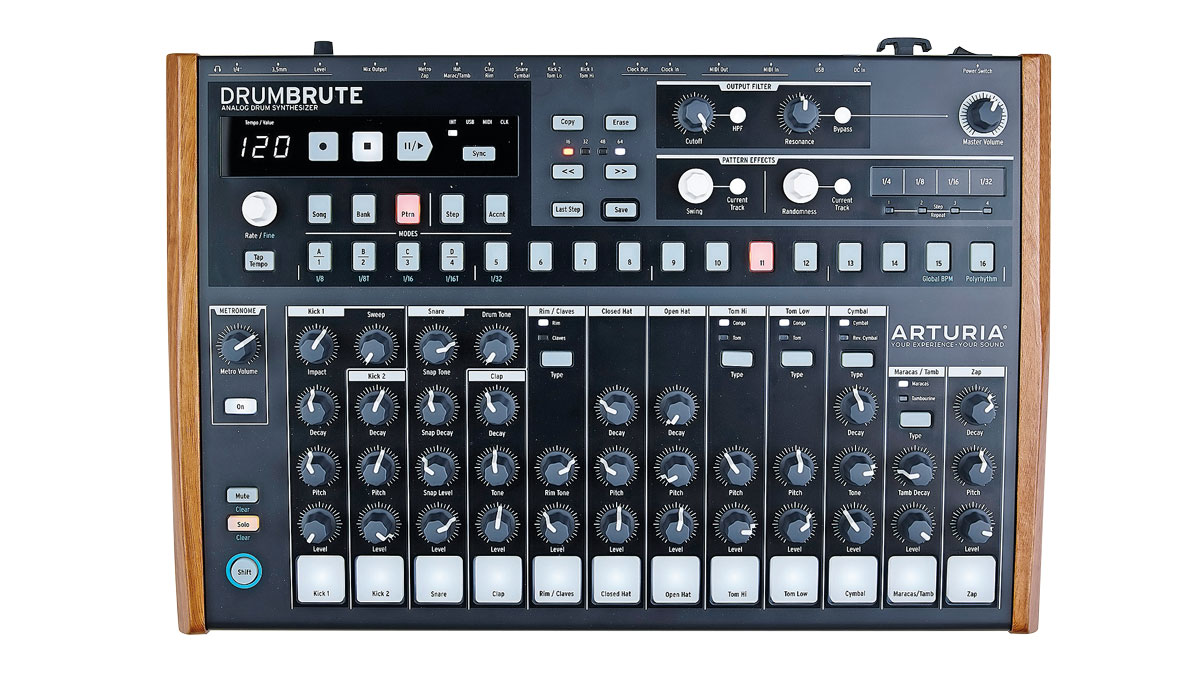9 ways to get more out of Arturia's DrumBrute
Get the beats rolling further with these tips for the powerful French groovebox

Released at the back end of 2016, the DrumBrute takes Arturia's experience in designing its BeatStep controllers, and mixes in the philosophy of the Brute range, providing a small-footprint, high-quality, analogue drum synth for a reasonable price.
You can read our original DrumBrute review to get the basics, but when you want to take your beatmaking further, here are nine tips to get even more from Arturia's small-but-deadly drumbox…
1. Erase like a champ
The DrumBrute's Copy and Erase buttons work on Bank, Patterns and individual drum tracks. You can also Spot Erase individual steps in real time by holding the Erase button and hitting the relevant pad.
2. Route sounds to external gear
The sounds associated with each of the DrumBrute’s 12 pads are accessible via separate outputs – simply plug a minijack into a sound’s output, and the associated sound is removed from the main mix (along with the filter in the signal path).
You may have noticed that the DrumBrute has 17 parts across 12 pads, so some sounds – while individually programmable – share an output. Rim and Claves, Toms and Congas, and Maracas and Tambourines. The exception is the Hats, which share both a mute group (the closed hat will always mute an open hat) and output.

3. Work with Velocity and Accenting
The DrumBrute's pads transmit and record the full 127-point velocity scale, but the internal sounds respond only to ‘normal’ and ‘accented’ notes, the effects of which are determined by the Accent Velocity Threshold parameter in the MIDI Control Center software.
The sounds themselves normally switch between quieter and louder versions (when played above the accent threshold), though the Accented version of some exhibit slight timbral changes too – for example, Kick 2 has a more noticeable ‘click’, and the Rim changes timbre as if the ‘Rim Tone’ parameter is being moved.
Want all the hottest music and gear news, reviews, deals, features and more, direct to your inbox? Sign up here.
4. Use Kick 2 as an extra tom sound
Repurposing sounds allows you to up your Tom count. Lower Kick 2’s Decay to 9 o’clock and it'll immediately fit with the Hi and Low Toms. You can even create four-note basslines using the Toms and Kicks simultaneously.
5. Get the DrumBrute in sync with other gear
Alongside its internal clock, the DrumBrute can sync (to and from) a large range of other gear via MIDI clock or USB. Analogue sync pulses are sent and received via a pair of rear-panel minijack connectors (Clock In and Clock Out), and the MIDI Control Center software adjusts the clock rate. Options include, amongst others, Volca- and DIN-compatible rates.
You can also turn on Auto-Sync, to switch to whichever source begins sending clock data to the DrumBrute. Note also that the clock ports carry both clock pulses and start/stop messages, though you may have to make up your own cable to make use of them.

6. Record and edit dynamics in your DAW
The DrumBrute’s main output can be processed by the resonant output filter (high- or low-pass). This, like all other sound-editing and manipulation parameters, cannot be automated internal or externally. The DrumBrute lends itself to tweaking on-the-fly, then, but if you want any sort of after-the-fact dynamic control, the best tactic is to record it through your DAW. For elaborate tweaks, loop the pattern and Solo each instrument for recording in turn. Keep the DAW running while you finesse the required changes, then select the best takes afterwards.
7. Update your firmware
It's not a glamorous thing to do, but keeping your firmware updated means that your DrumBrute will stay up-to-the-minute, giving you fixes for any bugs, and potentially extra functionality with each update.
8. Know how your metronome works
The metronome sound gets it own output, and it’s also removed from the main output when headphones are used. The sound is then routed to the headphones for tempo monitoring in a live situation.
9. Get all the features in the box
The MIDI Control Center is useful for managing and programming the ’Brute, but it's not simply a utility. It also allows access to extra features like the Step Repeat Randomizer, which can glitch up your sequences.
You can get more DrumBrute wisdom, including step-by-step walkthroughs and tutorial videos, in Future Music issue 318.


Future Music is the number one magazine for today's producers. Packed with technique and technology we'll help you make great new music. All-access artist interviews, in-depth gear reviews, essential production tutorials and much more. Every marvellous monthly edition features reliable reviews of the latest and greatest hardware and software technology and techniques, unparalleled advice, in-depth interviews, sensational free samples and so much more to improve the experience and outcome of your music-making.
